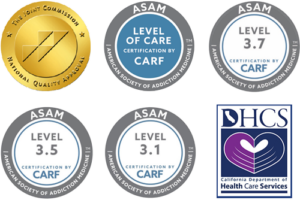How Long Does Adderall Stay in Your System?
Published on: July 8, 2025 | Updated on: December 3, 2025
Understanding Detection Times, Misuse Risks, and Treatment Options
Adderall is a prescription stimulant that helps manage attention deficit hyperactivity disorder (ADHD) and narcolepsy by improving focus and reducing impulsivity. When taken as prescribed, it can be highly effective — but its potential for misuse has also made it one of the most commonly misused prescription medications in the United States.
Understanding how long Adderall stays in your system is important for both medical safety and recovery awareness. For individuals who find themselves dependent on prescription stimulants, Adderall addiction treatment offers structured medical and psychological support to achieve stability and long-term recovery.
What Is Adderall and How Does It Work?
Adderall contains two central nervous system stimulants — amphetamine and dextroamphetamine — which increase dopamine and norepinephrine levels in the brain. These neurotransmitters regulate attention, motivation, and alertness, which is why Adderall is often prescribed to those with ADHD or chronic fatigue disorders like narcolepsy.
Under medical supervision, Adderall improves concentration and behavioral control. However, when used in higher doses or without a prescription, it can produce euphoria, anxiety, and physical dependence — the same traits seen in other addictive prescription drugs.
How Long Does Adderall Stay in Your System?
The amount of time Adderall remains detectable varies depending on factors such as dosage, individual metabolism, body composition, and whether it’s an immediate-release (IR) or extended-release (XR) formulation.
|
Testing Method |
Average Detection Window |
|---|---|
|
Urine |
2–4 days (up to 7 days for Adderall XR) |
|
Blood |
Up to 24 hours |
|
Saliva |
24–48 hours |
|
Hair |
Up to 90 days |
Factors That Affect Detection Time
Each individual’s body processes stimulants differently. The following factors determine how long Adderall stays detectable in your system:
-
Dosage and frequency: Larger or more frequent doses can extend detection times.
-
Metabolic rate: Faster metabolism accelerates elimination.
-
pH of urine: Acidic urine helps flush Adderall out faster, while alkaline urine prolongs retention.
-
Body composition: Hydration, weight, and muscle mass influence drug distribution.
-
Organ function: Healthy liver and kidney function support faster clearance.
These factors explain why two individuals using the same dose can show different results on a drug test.
Adderall Misuse and Its Health Risks
Adderall misuse often begins as an attempt to increase productivity or focus, but regular misuse can quickly lead to dependence. The body builds tolerance, requiring higher doses to achieve the same effect.
Chronic misuse increases the risk of severe health issues, including:
-
Elevated blood pressure and heart rate
-
Anxiety, paranoia, or panic attacks
-
Sleep deprivation and mood instability
-
Development of stimulant addiction
Over time, misuse can also mask or worsen underlying mental health concerns — a hallmark of dual diagnosis conditions that require integrated treatment.
How the Body Eliminates Adderall
Adderall is absorbed through the gastrointestinal tract, metabolized in the liver, and eliminated primarily through the kidneys.
The rate of elimination depends heavily on urine pH and overall organ function.
-
Absorption: Effects typically begin within an hour of ingestion.
-
Metabolism: The liver breaks amphetamine salts into inactive metabolites.
-
Excretion: The kidneys filter out both the parent drug and its byproducts, usually within several days.
This process explains why hydration and overall health can subtly influence how long Adderall remains in detectable form.
Adderall Withdrawal and Recovery
When the body becomes dependent on Adderall, abrupt discontinuation can trigger withdrawal symptoms such as fatigue, depression, slowed cognition, and sleep disturbances. Medical supervision during detox ensures safety and reduces the risk of relapse.
Comprehensive treatment for stimulant dependence may include:
-
Medically managed detoxification to stabilize withdrawal symptoms.
-
Cognitive-behavioral therapy (CBT) to address underlying triggers and habits.
-
Integrated care for co-occurring conditions like ADHD or anxiety disorders).
-
Long-term relapse prevention through individualized therapy and support networks.
For those struggling with chronic stimulant use, structured substance abuse treatment can help restore physical and psychological balance through evidence-based care.
Restoring Health After Adderall Dependence
Recovery from Adderall misuse involves more than ending substance use — it requires rebuilding focus, mental clarity, and emotional health. Journey Hillside Tarzana provides a medically supervised and compassionate environment designed to address both stimulant addiction and the mental health challenges that often accompany it.
Our programs combine clinical precision with individualized care to support each person’s path toward sustainable recovery and improved quality of life.
If you or someone you care about is struggling with Adderall use, call (877) 414-1024 to speak confidentially with our admissions team and take the first step toward recovery.





